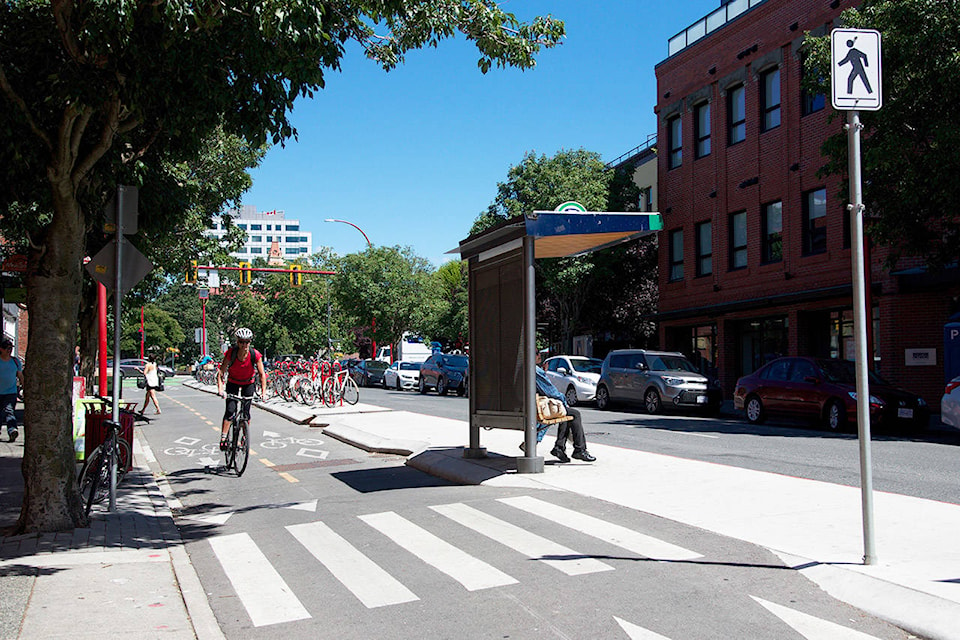Members of Victoria’s visually-impaired community have come forward with safety concerns about the Pandora bike lanes.
The biggest problem surrounds the bus stops along Pandora Avenue, which are stationed on meridians across from the bike lanes. While raised crosswalks are in place, there is no way for those with visual impairment to know when they can cross.
“I was standing on the bus stop island, waiting and waiting and thought ‘OK, it must be alright to go’ and I stepped out and a bike passed right in front of me,” said Linda Bartram, chair of the City of Victoria’s Accessibility Working Group, a volunteer group that aims to make policies, services, infrastructure and facilities more accessible. “I don’t hear the bikes until they’re literally in front of me.”
RELATED: Fort Street bike lanes officially open in Victoria
Bartram, who is visually impaired, was using the crosswalk as part of a demonstration to Brad Dellebuur, manager of transporation and infrastructure design at the City of Victoria. During the demonstration, Bartram and a partially sighted friend tried crossing both directions, and used both a guide dog and a white cane to test how people would react. Bartram said with her dog, she waited long enough that she could hear her bus passing.
“If I had actually wanted to catch it, I would have missed it,” she said.
When she used her cane, she eventually heard a cyclist joke that they were “at a standoff,” because he had stopped but didn’t know to tell her to go.
Bartram said the demonstration came into fruition after the lanes were already being constructed, because the Accessibility Working Group wasn’t formed until after planning decisions for the Pandora bike lanes had been made.
“We were only asked to comment on the bike lane accessibility to the bus stops, and as a blind person I couldn’t ascertain that it would be in the middle of the road,” she said. “We’ve been told it’s too late to do much about it in terms of changing things; but obviously this group feels something does need to be done.”
Brad Dellabuur said that after he saw the demonstration, he realized there was a problem.
“We came to the conclusion that we need to put some additional markings, which we’ve incorporated in Fort Street at mid-block crosswalks,” he said. “It’s just some additional information for cyclists that there is a legal requirement to stop.”
The additional “crossing ahead” signs are intended to warn cyclists that pedestrians may be ahead, and while they have been incorporated onto Fort Street, they have yet to be placed on Pandora Avenue.
Bartram said the additional signage would help, but that an ideal solution would be some kind of auditory signal that the visually impaired could use.
WATCH: City approves Wharf, Humboldt Street bike lanes
The difficulty spurred the Canadian Federation of the Blind to come forward with a complaint against the City with the B.C. Human Rights Tribunal. Oriano Belusic, vice-president of the federation, said the City’s actions have put blind peoples’ lives in danger.
“It’s like playing Russian roulette,” Belusic said. “Without eye contact, you really don’t know if you’re gonna get whacked by a bike.”
Belusic said his friend had his cane run over several times, and that he had personally encountered many near-misses.
“If you have a close call experience with a guide dog it could easily ruin their confidence to work, if they survive.”
In their claim, the Canadian Federation of the Blind is asking that the city tear up the floating bus islands, and allow busses to pick up riders from the safety of the sidewalk, noting that more signage does not do enough.
“In order for it to be safe, both parties need to be active in that safety,” Belusic said. “If I put my safety solely in the cyclist’s hands, that’s not good enough, it puts my life and my dog’s life at risk.”
RELATED: Lessons learned: City reflects on bike lane construction
Dellabuur couldn’t comment specifically on the case, but said the City is open minded.
“We’re always open to further design changes and refinements,” he said. “We’re happy to sit down and talk to everyone, we all want the same thing: safe, functional, enjoyable use of public space.”
